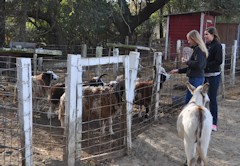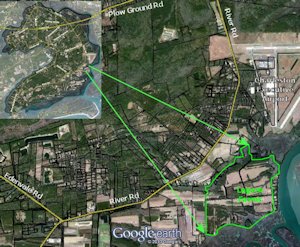Legare Farms
Legare Farms is a 300 acre working agricultural enterprise bordered on three sides by water: the Stono River on the east, Abbapoola Creek on the south and Hut Creek on the north. The property is an outstanding opportunity to conserve habitat and wildlife not only on the land but also in the surrounding river and salt marsh. The property and marsh are significant habitats for numerous species of resident and migratory birds.
Legare Farms is also an active agritourism, historic, and educational enterprise that provides outstanding opportunities for public participation at numerous events and programs including Fall Pumpkin Patch and Maze, Rent-a-Chick, Mud Run, Community Supported Agriculture, an annual Civil War Reenactment, a Summer Camp and the annual Harvest Dinner. The farm hosts numerous school groups and, through the Legare Farms Educational Foundation, helps teach local children about the lowcountry’s agricultural and cultural history through real life experience. The farm is also available for events held by other organizations and private groups.
 Greenbelt Bank and Lowcountry Open Land Trust
Greenbelt Bank and Lowcountry Open Land Trust
The Lowcountry Open Land Trust (LOLT) has been working quietly with the Legare family over an extended period to negotiate a conservation easement on the property. LOLT submitted an application to the Charleston County Greenbelt Bank and made an excellent presentation at the October meeting requesting funding for an easement. The Greenbelt Board voted unanimously to approve the funding. The Board consists of nine individuals from the private and non-profit sector appointed by County Council members. The Greenbelt money is funded by a half cent sales tax and is specifically allocated for projects such as this. This money is already available and requires no further levy on the public purse.
The Lowcountry Open Land Trust is South Carolina’s premiere organization for conserving open land through conservation easements. LOLT has a national reputation for excellence having protected over 88,000 acres in 13 counties. Indeed South Carolina, through innovative public private partnerships like the Greenbelt Bank and LOLT is a national leader in persevering habitat and rural spaces.
Conservation Easements
A conservation easement is a permanent restriction on a property limiting its uses, generally for agricultural and recreational purposes. More importantly an easement restricts development on the property allowing only a few houses of limited size to be built for the owner’s or future owner’s family. In the case of the Legare property current zoning, without this easement, would allow about 40 houses to be built. However the property could easily be rezoned to allow 300 hundred homes or even more with a County approved “planned developmentâ€. The conservation easement is a permanent contract on the property between the property owner and a certified sponsoring organization such as the LOLT. The easement is binding on all future property owners. The sponsoring organization is responsible for enforcing the easement and is granted by the easement all the legal rights necessary for doing so. For more information about conservation easements in general see the LOLT website:

Property Value and Compensation
Of course by signing such an easement the property owner is giving up significant value. In the case of Legare Farms, with current zoning, the property is appraised at $5.5 million. If restricted to permanent agricultural use by an easement the property is valued at $3 million. Why would a property owner do such a thing? There are three general reasons; first, a commitment to conservation and agriculture. This is the Legare family’s primary reason, they are passionate about their farm and Johns Island. The family history on Johns Island goes back 9 generations to the early settlement of the lowcountry. The second reason some people are willing to grant these easements is that they get a tax write off for the lost value. Of course a write off is only useful if you are wealthy; the Legares are not. What assets they have is all in their land and their hard work on it.

This is where the third reason for granting an easement comes in, Greenbelt funding. By state law, the creation of the Greenbelt Bank and the County’s Comprehensive Plan, the decision has been made that conservation of open spaces and rural uses is in the public interest. Outright purchase of these properties at their full development value would be prohibitive on the public treasury. Greenbelt funds are therefore allocated to partially compensate the landowner for the lost value. In the case of Legare Farms LOLT has asked for $900,000 to cover about a third of the lost value. The other $1.6 million is considered a “donation†by the Legare Family.
A “no-brainer”?
So far so good:
- A beautiful piece of property on the edge of the County’s rural boundary.
- Natural habitat and wildlife bordering environmentally sensitive marsh.
- An active farm with public access during scheduled events and educational programs.
- A dedicated, hard-working, passionate landowning family willing to grant a conservation easement.
- Sponsorship by THE premier regional land trust organization, LOLT.
- Readily available funds.
- Unanimous approval by the County’s Greenbelt Bank Board appointed by the County Council.
- Overwhelming precedent of County Council approving such funding.
Not so fast. The County Council decided they don’t like this one. They voted to reject their own advisory Board’s unanimous recommendation
(The vote was 5 – 2, two absent, at Thursday, November 14, Council Finance Committee meeting – committee of the whole Council).
Why?
 Councilman Darby has in the past indicated he prefers to use Greenbelt funds for outright purchases instead of for private easements. Private easements do not guarantee public access. He is reported to have voted against other conservation easement funds for this reason. While we disagree with Councilman Darby, he has a valid public policy reason and he has been consistent. As for the other council members, who have generally supported easements in the past, no reason has been given for their opposition to this particular easement. We are only left to speculate what motives they have.
Councilman Darby has in the past indicated he prefers to use Greenbelt funds for outright purchases instead of for private easements. Private easements do not guarantee public access. He is reported to have voted against other conservation easement funds for this reason. While we disagree with Councilman Darby, he has a valid public policy reason and he has been consistent. As for the other council members, who have generally supported easements in the past, no reason has been given for their opposition to this particular easement. We are only left to speculate what motives they have.
** UPDATE ** As this Post & Courier editorial describes, there is one more chance for the Council Finance Committee to reconsider if just one of the opposing council members will add back on December’s agenda.

 Diamondback Terrapin
Diamondback Terrapin

